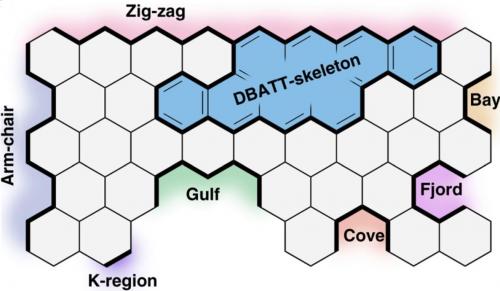
A team of scientists has succeeded in producing stable nanographene with zigzag edges. In nanoelectronics, graphene’s properties depend greatly on the shape of the carbon layer’s edges. Zigzag edges are highly desirable for nanoelectronics. Researchers have been trying to create zig-zag edges without success, that is, until now.
The researchers, from Friedrich-Alexander-University Erlangen-Nuernberg and Moscow State University, wrote about their work in the prestigious journal Nature Communications (citation below). The authors were Dominik Lungerich, Olena Papaianina, Mikhail Feofanov, Jia Liu, Mirunalini Devarajulu, Sergey I. Troyanov, Sabine Maier, and Konstantin Amsharov.
According to the authors, they used a relatively simple method to produce stable nanographene zigzag edges.
Bay, fjord, cove, armchair and zigzag
When chemists talk about nanographene, they often use the words zigzag, cove, fjord, armchair, and bay. They are referring to the shape of the edges of nanographene, i.e., tiny fragments of graphene.
Graphene, the toughest, lightest, and thinnest material in the world, consists of a single-layered carbon atom. Each carbon atom is surrounded by three others. Together, they create a honeycomb lattice with atoms in each corner.
Nanographene might well take over from silicon in the field of nanoelectronics. Nanographene, if it does take over, will bring microelectronics down to the nanoscale. Nanoscale technology involves counting dimensions in billionths of a meter (10-9m).
Zigzag periphery particularly suitable for electronics
The material’s electronic properties depend greatly on its size, shape, and most importantly, its periphery. In other words, the structure of its edges are hugely important.
A periphery with a zigzag shape is particularly suitable for microelectronics and nanoelectronics. In such cases, the electrons are more mobile than in other shaped edges. Electrons act as charge carriers.
If we use pieces of zigzag-shaped graphene in nanoelectronic components, it may allow higher frequencies for switches.
According to an FAU press release:
“The problem currently faced by materials scientists who want to research only zigzag nanographene is that this form makes the compounds rather unstable, and unable to be produced in a controlled manner. This is a prerequisite, however, if the electronic properties are to be investigated in detail.”
The researchers have succeeded in doing exactly that. Not only have they found a simple method for synthesizing zigzag nanographene, but also one that delivers a yield of nearly 100%. Additionally, it is suitable for large scale production.
The scientists have produced a “technically relevant quantity” in the lab.
The process for getting zigzag edges
The researchers initially produced preliminary molecules. They fitted them together in a honeycomb formation over many cycles in a process we call ‘cyclization.’
The graphene fragments are eventually produced from staggered rows of four-limbed stars or honeycombs surrounding a central point of four graphene honeycombs with the edges having the desired zigzag pattern.
This method produces stable zigzag nanographene because even during synthesis the product crystallizes directly. The molecules, in their solid state, are not in contact with oxygen. In solution, on the other hand, oxidation causes the structures to disintegrate rapidly.
Using their approach, the authors say they can produce large pieces of graphene while maintaining control over their periphery and shape.
According to FAU:
“This breakthrough in graphene research means that scientists should soon be able to produce and research a variety of interesting nanographene structures, a crucial step towards finally being able to use the material in nanoelectronic components.”
We can write the word with or without a hyphen, i.e., zig-zag or zigzag. Most people do not use a hyphen.
Citation
“Dehydrative π-extension to nanographenes with zig-zag edges,” Dominik Lungerich, Olena Papaianina, Mikhail Feofanov, Jia Liu, Mirunalini Devarajulu, Sergey I. Troyanov, Sabine Maier, and Konstantin Amsharov. Nature Communications, Volume 9, Article number: 4756 (2018). DOI: https://doi.org/10.1038/s41467-018-07095-z.
